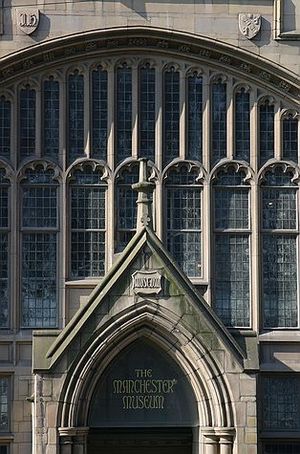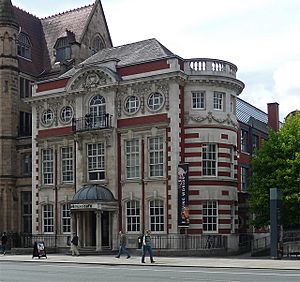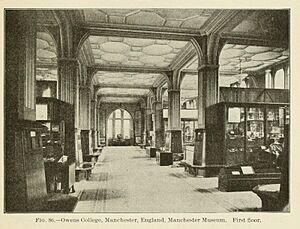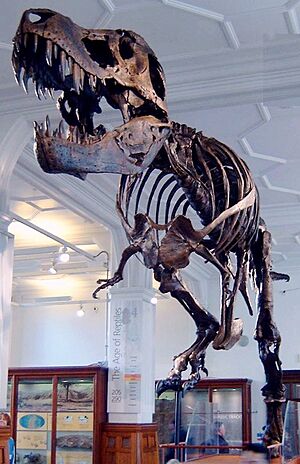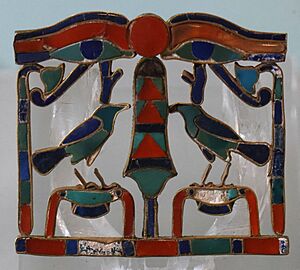Manchester Museum facts for kids
 |
|
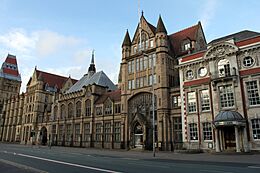 |
|
| Established | 1867 |
|---|---|
| Location | University of Manchester, Oxford Road, Manchester, England |
| Type | University museum of archaeology, natural history and anthropology |
|
Listed Building – Grade II
|
|
| Official name: Manchester Museum Extensions | |
| Designated: | 2 October 1974 |
| Reference #: | 1246283 |
The Manchester Museum is a super cool place in Manchester, England. It's owned by the University of Manchester. This museum is packed with amazing things like ancient artifacts, items from different cultures, and lots of natural history displays.
You can find it on Oxford Road (which is also the A34) right in the middle of the university's beautiful old buildings. It holds about 4.5 million items from all over the world! It's actually the biggest university museum in the UK. Lots of people visit every year, and it's also a place where scientists and students do important research and learning.
Contents
- Museum History
- Exploring the Galleries
- Amazing Collections
- Anthropology: Cultures of the World
- Archaeology: Ancient Discoveries
- Archery: Bows and Arrows
- Botany: Plant Life
- Earth Sciences: Rocks and Fossils
- Entomology: Insects Galore
- Amphibians: The Vivarium
- Mammals: Furry Friends
- Birds: Feathers and Flight
- Corals: Underwater Wonders
- Molluscs: Shells and Snails
- Returning Ancient Items
- See also
Museum History
The museum's first collections started way back in 1821. A group called the Manchester Society of Natural History bought a collection from a person named John Leigh Philips. They opened their first museum in 1835 on Peter Street in Manchester. Later, in 1850, collections from the Manchester Geological Society were added.
By the 1860s, these societies faced money problems. A famous scientist, Thomas Huxley, suggested that Owens College (which is now the University of Manchester) should take care of the collections. So, in 1867, the university took over. The old museum building was sold in 1875.
The college then asked Alfred Waterhouse to design a new museum. He was the same architect who designed the famous Natural History Museum in London! The Manchester Museum opened to the public in 1888. It was built so students could easily access the galleries from their classrooms.
Over the years, the museum grew with two big additions. In 1912, a new part was built to hold ancient Egyptian and archaeological items. This was thanks to money from Jesse Haworth, a textile merchant. Then, in 1927, another section was added for items from different cultures around the world.
Exciting New Changes
The Manchester Museum closed for a while on August 29, 2021, for a huge makeover. This was the final part of a £13.5 million project to make the museum even better.
The renovated museum now has a new two-story extension and brand-new galleries. These include a large Exhibition Hall, a "Belonging Gallery," the "Lee Kai Hung Chinese Culture Gallery," and the "South Asia Gallery." The "South Asia Gallery" is the first permanent exhibition in the UK dedicated to the stories and contributions of South Asian communities. The museum reopened on February 18, 2023, and welcomed 52,000 visitors in its first week!
Exploring the Galleries
In 1997, the museum received a lot of money from the Heritage Lottery Fund and other groups. This helped them make big improvements, and the museum reopened in 2003. During this time, they created the "Fossils Gallery," "Living Cultures Galleries," and the "Vivarium."
The "Manchester Gallery" helps visitors understand how the museum, Manchester, and the rest of the world are connected. It also looks at where the collections came from and how they relate to history.
The "Living Worlds" gallery opened in 2011. It's a special natural history gallery that encourages you to think about nature. You can see interesting exhibits like a crane with a piece of rubble from the Hiroshima atomic bomb blast. The gallery also has an outdoor garden where volunteers grow plants and teach visitors about gardening.
"Ancient Worlds" opened in 2012. This area shows how people learn about the past using old objects. You can see how scientists reconstruct faces from ancient remains. It also takes you on a journey through the world of the Ancient Egyptians.
In 2013, something very strange happened! A 10-inch Egyptian statue in the museum seemed to spin around by itself. This got attention from all over the world! Scientists thought it might be caused by tiny vibrations from visitors. The museum's Egyptologist, Campbell Price, said it had never moved before. This mystery made many more people want to visit the museum!
"Nature's Library" opened in 2013. It displays the museum's huge collection of natural history items. The design looks like an old Gothic library. It helps you explore the amazing variety of the natural world.
In 2004, the museum got a copy of a fossilized Tyrannosaurus rex skeleton. This T. rex is named "Stan" and is shown in a running pose. It's based on one of the most complete T. rex skeletons ever found!
The museum also had a temporary exhibition called Myths About Race in 2007. It explored difficult topics from history and how museums have changed over time. In 2008, a famous bog body called Lindow Man was on display for a year.
Amazing Collections
The Manchester Museum has many different types of collections. Here are some of the highlights:
Anthropology: Cultures of the World
This collection has about 16,000 items from different cultures. Almost half of them are from Africa. A quarter are from Oceania, and many others come from Asia and the Americas. You can see ancient pottery from Peru and carvings from the Eskimo people. There are also weapons and paddles from the Pacific islands.
Archaeology: Ancient Discoveries

The archaeology collections focus on Western Europe, the Mediterranean, Egypt, and Western Asia. Many items from Egypt and Western Asia came from the excavations of Sir Flinders Petrie. The museum has finds from ancient sites like Kahun and Gurob.
The museum is famous for its Egyptian mummies! Since 1973, scientists have studied these mummies to learn about health and life in ancient Egypt. They use special tools like X-rays and endoscopes to study them without unwrapping them. One mummy, number 1770, was completely unwrapped in 1975. The archaeology collections were updated and redisplayed in 2011 in the "Ancient Worlds" galleries. The museum also cares for a bog body called Worsley Man.
Archery: Bows and Arrows
This collection has about 2,000 items related to archery. It started with a donation from Ingo Simon in 1946. He was a very skilled archer and studied the history of bows. The collection includes items from Great Britain, Brazil, Japan, and many other places.
Botany: Plant Life
The Manchester Herbarium holds over 950,000 plant specimens! These were collected over hundreds of years from almost every country. You can find specimens collected by famous people like Carolus Linnæus and even from the expeditions of Charles Darwin.
Earth Sciences: Rocks and Fossils
The geological collections are very important. They include over 9,000 mineral specimens and hundreds of thousands of fossils. You can see fossilized plants from the Coal Measures, ammonites, and even an ichthyosaur from Whitby. The museum also has 40,000 mammal bones from an excavation site.
Entomology: Insects Galore
The museum's insect collection has almost 3 million specimens! This includes 10,500 "type specimens," which are the original examples used to describe new species. About half of the collection is made up of beetles. You can even see one of only three known specimens of the rare Manchester moth.
Amphibians: The Vivarium
The museum's "Vivarium" houses a collection of live amphibians. Some of these are critically endangered species from places like Madagascar and South America. The displays let you watch these amazing creatures in habitats that look like their natural homes. The museum also works on breeding programs to help save these rare frogs.
Mammals: Furry Friends
This collection includes thousands of mammal specimens. You can see mounted animals like a lowland gorilla, an aye aye, and a red panda. There are also many bones and skulls from a wide range of mammals.
Birds: Feathers and Flight
The bird collection has about 15,000 bird skins from over 2,000 species. It includes a warbler finch collected by Charles Darwin on the Galapagos Islands in 1835! You can also find bones of the dodo and an elephant bird egg. The museum has eggs from about 10,000 different sets.
Corals: Underwater Wonders
The museum has many coral specimens, including some "type specimens" that were used to name new coral species. These came from Sydney Hickson, a professor who specialized in corals.
Molluscs: Shells and Snails
This is the fourth largest mollusc collection in Britain, with 166,000 groups of specimens. It includes collections from many different naturalists and explorers.
Returning Ancient Items
The Manchester Museum is also involved in an important project called "repatriation." This means returning sacred artifacts to the Indigenous Australian peoples they originally belonged to.
In November 2019, the museum returned 43 secret and ceremonial items to Aboriginal and Torres Strait Islanders communities in Australia. This was a big step in recognizing past harms and encouraging healing.
In September 2023, the museum returned another 174 artifacts to Indigenous Australian people. This act encouraged other museums to do the same. Women from the Anindilyakwa community received carvings, baskets, decorations, and a large collection of shell dolls.
See also
 In Spanish: Museo de Mánchester para niños
In Spanish: Museo de Mánchester para niños


